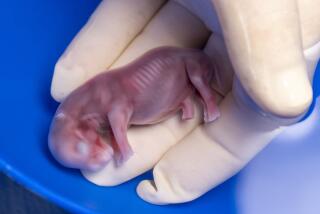Healthy Monkey Is Genetically Engineered by Oregon Researchers
- Share via
Oregon researchers have genetically engineered a monkey, one of the closest relatives of humans--a major advance toward producing primates with human genetic diseases as a research tool to find new cures.
The team inserted a marker gene into the egg of a female rhesus monkey, fertilized it and brought the embryo to term. The baby monkey, born in October, was named ANDi and appears completely healthy.
Because of the considerable technical difficulties involved in producing the animal, however, the achievement is not considered a significant step toward genetically engineering humans.
Biologists have previously genetically engineered a broad variety of farm animals, including pigs, cows and sheep. Genetically engineered mice are routinely used in laboratory studies of disease. But it is a big leap from mice to humans, and many research projects require animals, such as monkeys, that more closely mimic human biology.
Genetically engineered monkeys can “literally bridge the gap between mice and people,” said biologist Gerald Schatten of Oregon Health Sciences University in Beaverton, who led the team that produced ANDi and that reports the achievement in today’s Science.
Producing genetically engineered primates has proved particularly difficult, both because of the problems inherent in working with primate cells and researchers’ limited experience with artificial reproduction in monkeys and related species.
“This research breaks a technical barrier,” said Dr. Duane Alexander of the National Institute of Child Health and Human Development, which funded the research. “The technology paves the way for developing new models for testing treatments for a variety of diseases [such as cancer, cystic fibrosis and Alzheimer’s disease] in a more relevant way than is currently possible.”
Schatten and his colleagues inserted the gene for a substance called green fluorescent protein into the DNA of 224 eggs isolated from female rhesus monkeys. The protein serves no useful biological function, but it fluoresces under ultraviolet light, enabling scientists to identify its presence in the target animal.
The eggs were fertilized with monkey sperm, leading to the formation of 40 embryos, which were implanted two at a time into 20 surrogate mothers. That process led to five pregnancies, which resulted in three live births. A pair of twins miscarried.
One of the three monkeys born was shown to carry the gene for the fluorescent protein, and was named ANDi--backward for “inserted DNA.”
Although the gene is known to be incorporated into ANDi’s DNA, it is not yet producing protein, Schatten said. They are not sure why. In a practical application, this would present a problem, because the point of inserting a gene is to produce the protein.
Even if the protein were being produced, Schatten said, ANDi would not be green and would not fluoresce, because only a small amount would be produced. “This is not a Day-Glo monkey.”
He noted that, in many transgenic animals, the added genes do not produce proteins for the first year or so. Fingernails and hair from the miscarried monkeys did fluoresce, however. Schatten suggested that they miscarried because rhesus monkeys rarely successfully carry twins to full term.
Some ethicists question genetic experimentation on primates because they have more complicated thought processes than other laboratory animals. But many more are concerned that such experiments bring us closer to the day when similar attempts are made in humans.
ANDi “is a primate and looks like us, sort of. It is a reminder that we will have to confront the making of heritable changes in humans,” said USC ethicist Alexander Capron. But scientifically, he said, the monkey is “hardly more of a harbinger of human genetic engineering than modified mice, pigs and other animals. In some ways, it’s less advanced if the marker gene isn’t functioning.”
“This represents moving technology into a species that’s closer to humans, and it would be a thoroughly bad idea to apply this to human beings,” said Dr. Stuart Newman of New York Medical College. Like some others, he fears that a partially successful attempt in humans would lead to “people walking around with mental and physical defects caused by doing this experiment.”
Schatten said he has no plans to make large numbers of genetically engineered monkeys, but he thinks they could be very useful in selected applications.
Researchers have recently shown that a vaccine against Alzheimer’s disease works well in mice that have been genetically engineered to produce the disorder. Similar tests in monkeys would prove very useful before the vaccine is tried in humans, he said.






